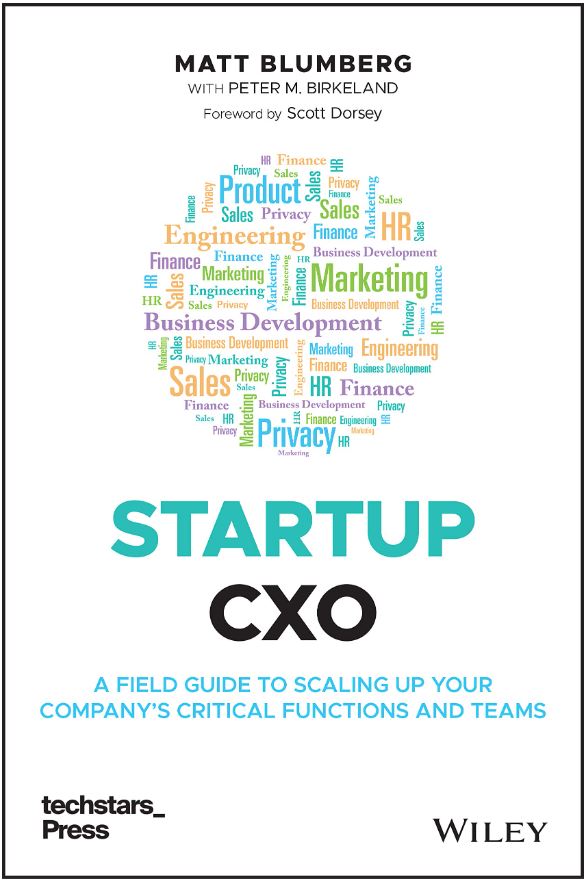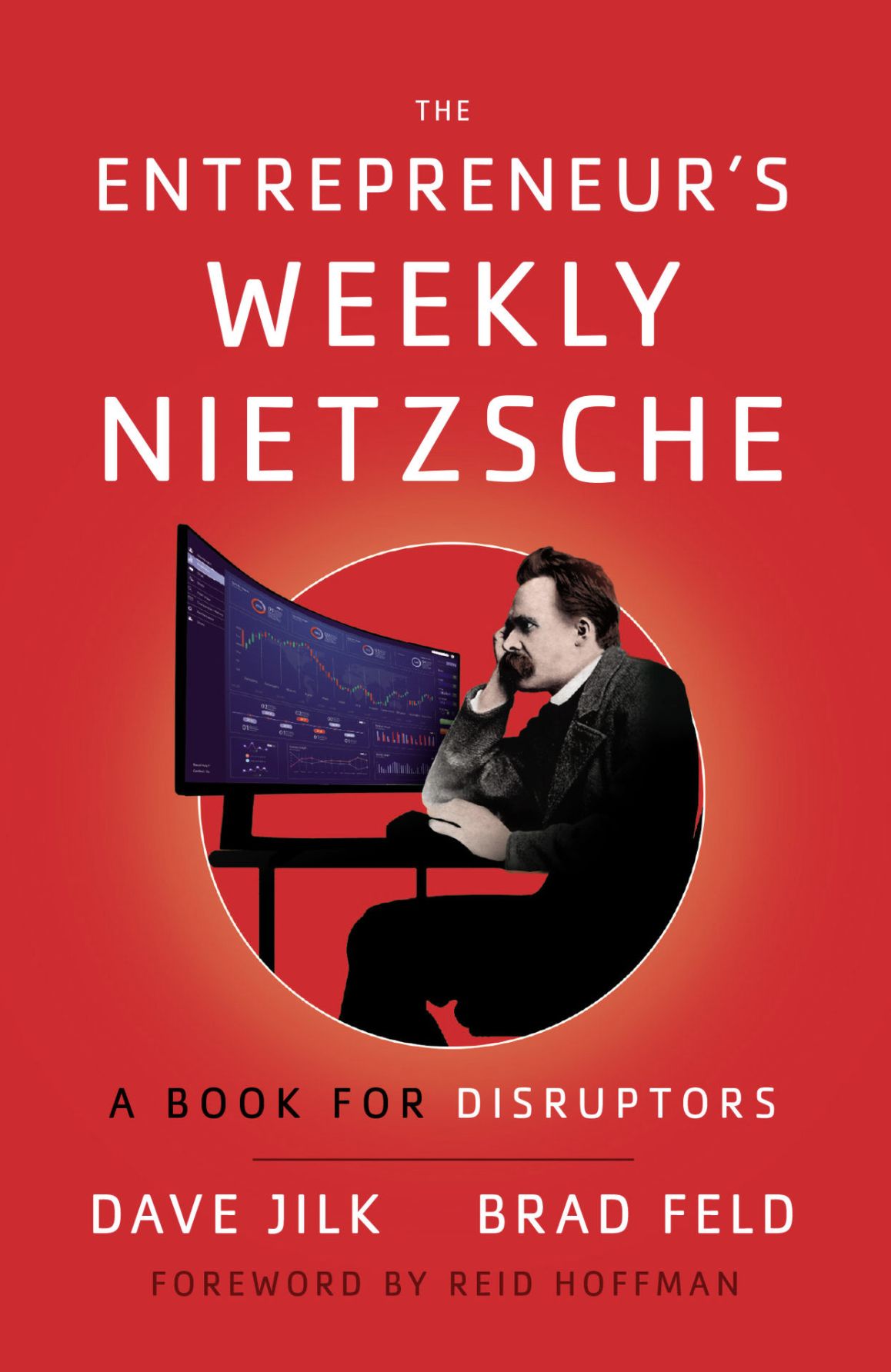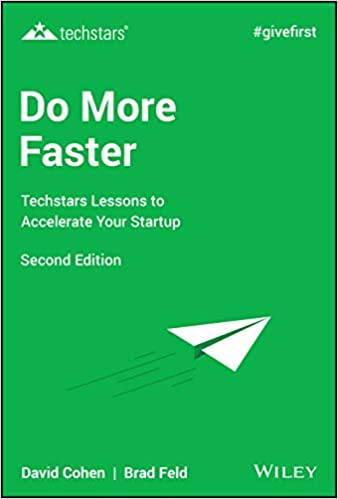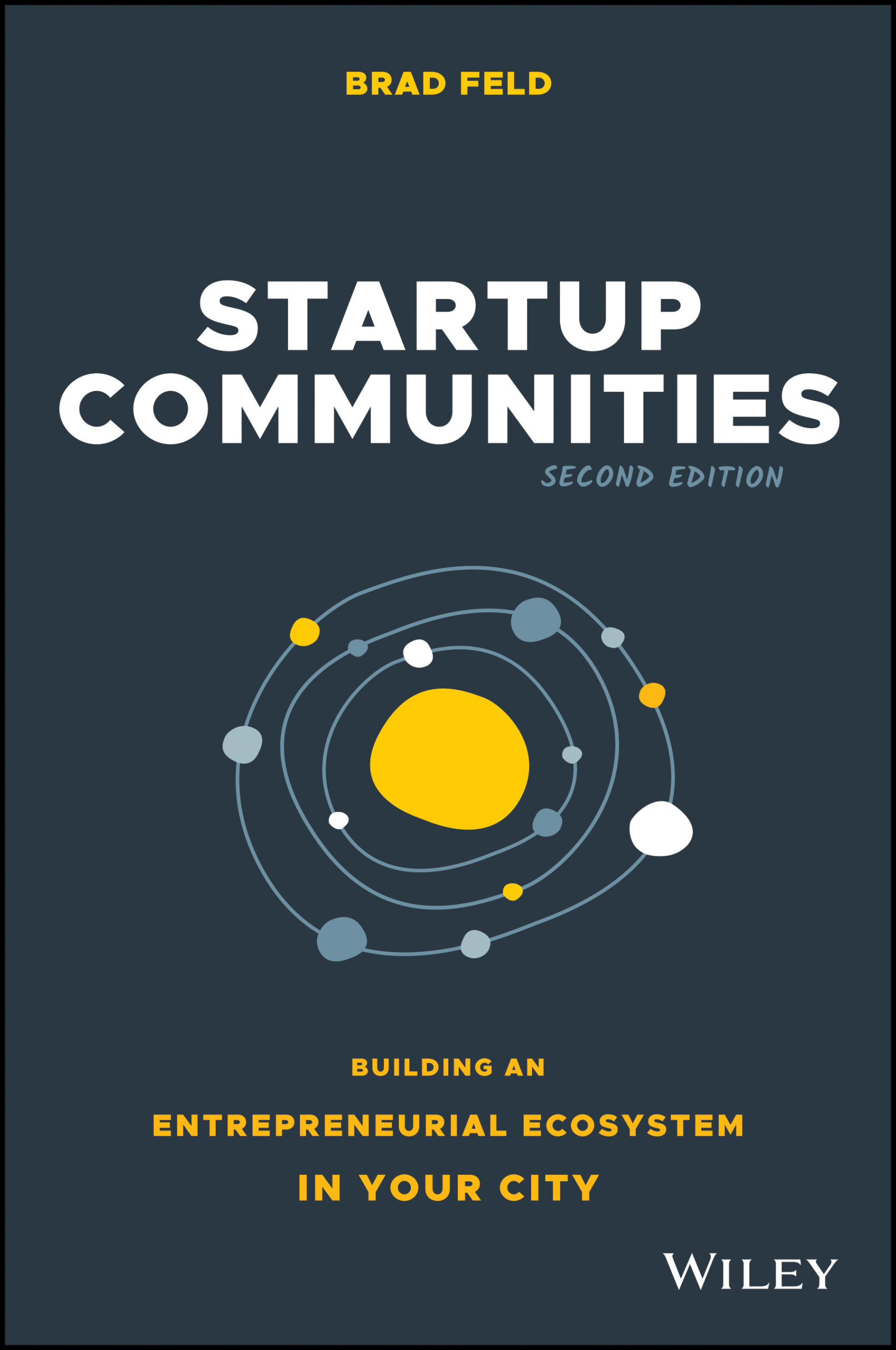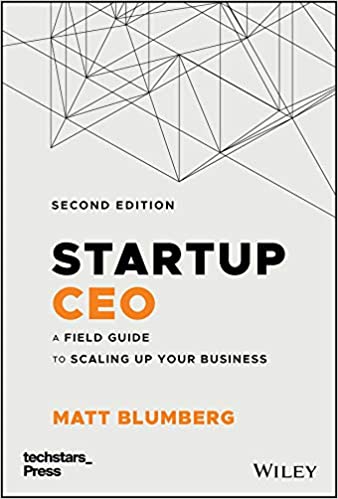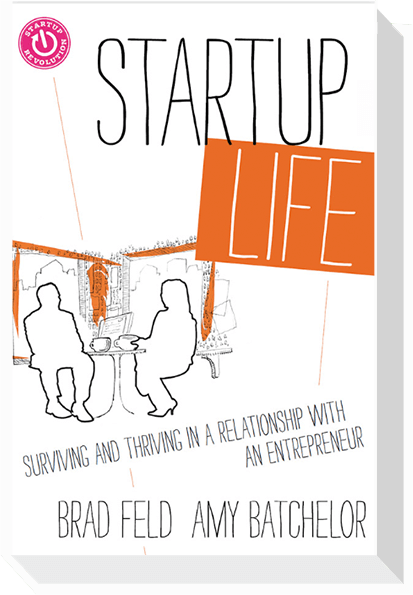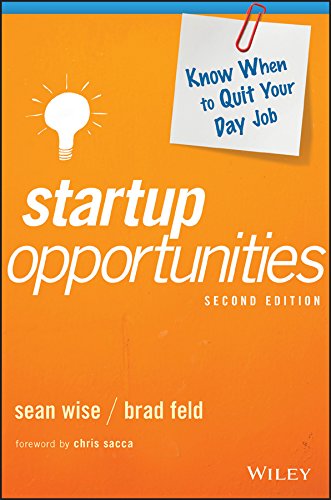Startup Communities Revisited
Writing a book is a very hard thing. It’s one of the hardest things I’ve done professionally. It is the nonlinearity of the process that makes it so difficult and the sheer perseverance that’s required. It’s remarkable to see how different the content is today compared with where it was on day one.
Part of the process means writing a lot of words that no one will ever see. I have written literally tens of thousands of words—several complete chapters even—that will never see the light of day. I was going through one of those today and decided I will publish it here. It is a brief summary of Brad‘s book Startup Communities: Building an Entrepreneurial Ecosystem in Your City, meant to be a refresher for those familiar with the material and to quickly get newcomers up to speed. I also added layers of my own context, data points, and interpretation.
And with that, at the risk of depriving Brad of some royalties and pissing off his publisher, here is my condensed version of Startup Communities.
***
We know that you read Startup Communities (“SC1”) on more than one occasion and handed it out at your office summer party. But, in case you are forgetful or your mother-in-law wants to better understand what you do for a living without having to miss out on her tennis match later, in this chapter we revisit the main themes of SC1 and provide a concise guide for newcomers to get up to speed.
This chapter is not a substitute for actually reading SC1 (which you should do), though we think you can grasp many of the high-level concepts here quickly. If you have already mastered the content in SC1, feel free to skim through this chapter to refresh your memory or go a bit deeper in certain areas, even referring back to the first book as you go along—perhaps you’ll see something in a different way this time.
ABOUT BOULDER
Boulder made for an exemplar case study in SC1 for three reasons. First, it is a vibrant and sustainable startup community. Second, it is unlike other leading startup hubs, such as Silicon Valley, San Francisco, Boston, and New York. Finally, Brad has lived in Boulder since 1995 and has been actively engaged with its development—giving him an intimate view of the internal dynamics of the startup community there.
Boulder has some defining characteristics.
Boulder is a small city. With a resident population of approximately 108,000 and a broader metropolitan area of more than 322,000 people, Boulder is just the 155th largest metro area in the United States and the 4th largest in the State of Colorado. In terms of population density (inhabitants per square mile), Boulder ranks 64th nationwide, and is one of the most densely populated mid-size metropolitan areas in America.
Boulder is a smart city. The University of Colorado Boulder is a major research institution of more than 37,000 students, faculty, and staff situated near the center of town. Boulder hosts three national labs, including the National Oceanic and Atmospheric Administration (NOAA), National Center for Atmospheric Research (NCAR), and National Institute of Standards and Technology (NIST), and has the highest concentration of adults with advanced degrees among large- and mid-size U.S. metropolitan areas.
Boulder is an innovative city. According to a 2013 Brookings Institution study, Boulder ranked 33rd among US metro areas in terms of patenting activity between 2007-2011, but ranked sixth when scaling for the size of the workforce. Similarly, venture capital investment in the Boulder metro area ranked 16th nationally in 2016-17, but when adjusted by the size of the community, it ranks third—behind only San Francisco and San Jose (Silicon Valley). Google will soon open a new 330,000 square foot campus near downtown Boulder that will employ 1,500 people.
Boulder is an entrepreneurial city. A Brookings Institution study of the fastest growing firms in the United States ranked Boulder first on a per-capita basis, while a joint report by Kauffman and Engine found that Boulder leads the nation in high-tech “startup density,” and by a long shot too—at more than six times the national average. The overall rate of new business formation places Boulder among the top ten percent of major metros nationally. Livability, a website that ranks quality of life factors in small and medium sized cities, recently rated Boulder as the best city in America for entrepreneurs.
Boulder is an attractive city. With nearly 250 predominantly sunny days per year (no, it’s not 300 as popular legend states), Boulder is among the sunniest cities in America. Its access to the Rocky mountains attracts adventure-seekers, and a plethora of high-end restaurants, shopping, and entertainment, gives the young and active plenty to do. Richard Florida, an urbanist, ranks the Boulder metro fifth for concentration of workers in the “creative economy”—meaning that Boulder is home to not just techies, scientists, and other highly skilled professionals, but also plenty of artists, musicians, and other creative types that help feed an innovative, dynamic, and vibrant economic system.
Having these factors is a major advantage for Boulder’s startup community—brains, capital, a knack for innovation, an entrepreneurial spirit, and an exciting, thriving place to live are critical factors for creating and sustaining a vibrant startup ecosystem. But, they alone are not enough. Many cities have smart people, innovative activity, a density of startups, and an array of amenities, but lack the entrepreneurial vigor of Boulder. The difference lies in the way these ingredients are mixed together, primarily by means of human relationship. The difference is culture and social norms. That’s what startup communities is fundamentally about.
THE BOULDER THESIS
The main intellectual novelty of SC1 is the Boulder Thesis—a framework that explains why a small city of just over 105,000 residents is able to consistently produce a steady drumbeat of high-impact startups. More specifically, when looking at the leading startup hubs in the United States and globally, Boulder doesn’t look like the others—even among well-educated cities with universities, flagship companies, and attractive amenities. Something about Boulder is different. Woven into the fabric of the Boulder startup community is a way of combining these inputs that has given fledgling companies there a better chance of success. That has been distilled into the Boulder Thesis. It has four key components:
Entrepreneurs must lead the startup community. Although a range of participants are critical to a startup community—including government, universities, investors, mentors, and service providers—the entrepreneurs must lead organizing efforts. Entrepreneurs here are defined as those who have founded or co-founded a growth-oriented startup.
The leaders must have a long-term commitment. Entrepreneurs must be committed to building and maintaining a startup community over the long-term. Leaders should take at least a twenty-year view—a view that refreshes every year (the horizon is always twenty years out). For a startup community to be lasting, it must be bigger than the latest fad or as a response to an economic downturn.
The startup community must be inclusive. Startup communities should embrace a philosophy of extreme inclusion. Anyone who wants to get involved should be able to, whether they are new to town or new to startups, or whether they are company founders, employees, or simply want to help out. A startup community that embraces diversity and openness is a more flexible, adaptable, and resilient startup community.
The startup community must have continual activities. It’s important that the span of participants in a startup community are constantly engaging—not through passive events like cocktail parties or award ceremonies, but through “catalytic” events like hackathons, meetups, open coffee clubs, startup weekends, or mentor-driven accelerators, which are venues for tangible, focused, engagement among members of the startup community.
THE IMPORTANCE OF GEOGRAPHY
A dense co-location of businesses is valuable for many sectors of the economy, because it lowers transaction costs and improves matching between firms, labor, suppliers, and customers. These “agglomeration effects” or “external economies” (economies of scale that exist outside the firm, often at the local or regional level) are particularly important in industries where specialized inputs and highly-skilled workers are important to production (a “bigger pool” of resources to draw from).
Beyond lowering transaction costs and improved matching, a third benefit to density is vital to innovation and entrepreneurship—a concept economists refer to as “knowledge spillovers,” or the exchange of ideas. In complex activities like starting and scaling innovative businesses, idea exchange and learning from others is critical. Because complex concepts are difficult to transfer verbally or in writing, learning of this nature is best done at an arm’s length (“learning by doing” or “learning by seeing”).
Brad has written on his Feld Thoughts blog (www.feld.com) about the phenomenon of startup density and the importance of density to entrepreneurial performance. As one example, he describes that when doing business in well-known startup hubs like San Francisco or New York, he tends to stay in a relatively confined area. This is particularly true in Boulder, where most of the startup activity is concentrated in a relatively confined space of about 40 square blocks.
Academic research confirms that measuring startup density at the level of cities or metropolitan areas is probably not fine enough, having established a high “decay rate” of knowledge sharing over distances. One study found that the benefits of knowledge sharing in the software industry, for example, are ten times greater when co-locating within one mile of similar companies versus within two-to-five miles. Another study found that the benefits of co-location among advertising agencies in Manhattan were fully depleted after just 750 meters.
To quote Maryann Feldman, an expert on the geography of innovation:
“…geography provides a platform to organize resources toward a specific purpose. While firms are one well-known way to organize resources, location provides a viable alternative—a platform to organize economic activity and human creativity… More than facilitating face-to-face interaction and the exchange of tacit knowledge, geography enhances the probability for serendipity—the chance for something unexpected to have a profound and transformative impact.”
Visionaries like Steve Jobs understood this, which is why he designed the Pixar office in a way that would force “spontaneous collisions” among colleagues from different disciplines. Google, Facebook, and other highly innovative companies have followed suit. They don’t provide free food and table tennis for nothing, and it’s not just to give overworked engineers a fun way to destress—it’s to get people who might not otherwise engage with one another to open up, share ideas, and find new ways to collaborate.
NETWORKS OVER HIERARCHIES
Advanced and emerging economies alike have been undergoing a massive transformation in recent decades, from centralized, command-and-control structures of the industrial era, to decentralized, network-centric organizational forms of the information age.
Hierarchies are best suited for conditions that require tight control of production or information, such as manufacturing facilities or in large bureaucracies (universities, government). Hierarchies require formal rules and standard operating procedures. Networks, on the other hand, require flexibility and horizontal flows of information. Startup communities rely upon unencumbered information flows and therefore thrive in network structures such as these. Conversely, they die under hierarchical control.
This thinking, and Brad’s writing about it in SC1, is heavily influenced by the Berkeley economic geographer AnnaLee “Anno” Saxenian, in her seminal work Regional Advantage: Culture and Competition in Silicon Valley and Route 128. This book is probably the most important book ever written on how to think about what makes some regions consistently more innovative and entrepreneurial compared with others.
In her work, Saxenian compared two technology hubs—California’s Silicon Valley and the Route 128 Corridor near Boston—that looked similar as late as the mid-1980s in terms of their ability to produce a high rate of information technology businesses. From there, however, the Route 128 region spiraled into a state of deep decline while Silicon Valley pulled further ahead in the global technology race. What changed? A period of intense, rapid technological disruption and increased global competition left the more rigid hierarchical structure of Boston flat-footed and unable to quickly adapt, whereas the network-based structure shaped by Silicon Valley’s open culture of “collaborative competition” made it better-positioned to capitalize on these changes.
As Brad summarized in the first book:
“Saxenian persuasively argues that a culture of openness and information exchange fueled Silicon Valley’s ascent over Route 128. This argument is tied to network effects, which are better leveraged by a community with a culture of information sharing across companies and industries. Saxenian observed that the porous boundaries between Silicon Valley companies, such as Sun Microsystems and HP, stood in stark contrast to the closed-loop and autarkic companies of Route 128, such as DEC and Apollo. More broadly, Silicon Valley culture embraced a horizontal exchange of information across and between companies. Rapid technological disruption played perfectly to Silicon Valley’s culture of open information exchange and labor mobility. As technology quickly changed, the Silicon Valley companies were better positioned to share information, adopt new trends, leverage innovation, and nimbly respond to new conditions. Meanwhile, vertical integration and closed systems disadvantaged many Route 128 companies during periods of technological upheaval.”
We’ll go deeper on networks throughout the rest of the book, but the important point here is that startup communities thrive in environments where information, talent, and capital flow freely and horizontally through relational networks.
ATTRIBUTES OF LEADERSHIP IN A STARTUP COMMUNITY
SC1 listed four key attributes of leadership in a startup community. In the vernacular of the Ten Commandments, these can be thought of as the “dos” of the startup community.
Be inclusive. Leaders of the startup community should embrace anyone who wants to engage, regardless of experience, background, education, gender, ethnicity, perspective, and so on. Startup community leaders serve as gatekeepers, and have a duty to ensure the door is open to anyone. As a common point of first contact, leaders should introduce newcomers or visitors to high-impact, easy-to-access events and a handful or two of key individuals. Finally, leaders should nurture and make room for the next generation of leaders—eventually handing off existing activities, and taking on new responsibilities.
Play a non-zero-sum game. Many approach human and business relationships as a zero-sum game—there are winners and there are losers. This thinking has no business in a startup community. Participants must fully embrace the notion of increasing returns—everyone gains more by contributing positively to the collective.
Be mentorship driven. Give to others. A good mentor has no expectations of what he or she will get out of it—instead, they approach it with a “give before you get” dynamic, with a willingness to let the relationship evolve naturally. Leaders, in particular, must embrace the mentorship role, and build time for it into their regular activities. This should occur on three levels—mentoring future leaders, mentoring other entrepreneurs, and mentoring each other. Finally, lead by example.
Have porous boundaries. The best startup communities know that it’s beneficial to be open—leaders should talk with one another other, sharing strategies, relationships, ideas, and resources. Individuals who come and go should be embraced and welcomed back when they return.
CLASSICAL PROBLEMS IN A STARTUP COMMUNITY
Continuing with the Ten Commandments theme, SC1 listed ten common problems that occur in a startup community—these are the “don’ts”.
Patriarch problem. Also known as the rich old guy problem, this occurs when people try to control the startup community, restricting rather than enabling the next generation of leaders. In these controlled environments, it matters who you know, not what you know. If we haven’t said it enough before, we’ll say it again—startup communities thrive in networks, not hierarchies. To get around patriarchs, entrepreneurs should play the long game (wait for them to die off) or simply ignore them.
Complaining about funding. There will always be an imbalance between the supply of capital and the demand for it. Some local initiatives can improve things on the margin, but the underlying problem persists. At the very least, complaining about it won’t help. Instead, entrepreneurs should concentrate on something they can control—building a great business around a problem they are obsessed about solving.
Being too reliant on government. Relying on government to either lead or provide key resources for building a startup community is a misguided view over the long term. In spite of some successful efforts and the best of intentions, governments generally lack the resources, expertise, mindset, and sense of urgency to effectively mobilize resources that entrepreneurs need most.
Making short term commitments. It takes a long period of hard work to get a healthy startup community up and running in a sustainable way—at least a generation of effort (twenty-year view). Strategies rooted in the current economic cycle, political calendar, or latest trend aren’t sufficient to achieve this. And while we’re at it, this generational clock resets every year—leaders should always have a twenty-year view.
Having bias against newbies. Vibrant startup communities, like Boulder, welcome newcomers and visitors with open arms. Shunning “outsiders” or demanding that newbies “earn their way” into the startup community is a dumb, outmoded way of thinking. It is the thinking of hierarchies. Startup communities are not hierarchies.
Attempt by a feeder to control the community. In some cases, non-entrepreneurs (“feeders”) masquerade as leaders or try to control the startup community—this stifles both short- and long-term growth. Venture capitalists, governments, and universities are some of the worst offenders of this principle. It is no coincidence that many of these also operate in a hierarchy, where top-down control is a natural force.
Creating artificial geographic boundaries. Within cities, multiple startup communities can exist. For example, in the Boston metro area there are several: in Boston, there is the Financial District, Innovation District, and South End, and in Cambridge there is Kendall, Central, and Harvard Squares. Ideas do not flow in a linear fashion, and efforts to confine them to arbitrary administrative boundaries impede them.
Playing a zero-sum game. See earlier—playing a zero-sum game isn’t helpful for startup communities, including when competing against neighboring communities for the sake of promoting your own. Instead, take a network-based approach and connect your startup community with neighboring ones. Learn from each other. Share ideas.
Having a culture of risk aversion. Persistent risk aversion is another obstacle to startup community development. It typically manifests in two forms: (1) a concern about investing time in something that doesn’t end up having an impact, and (2) the fear of rejection by other people in the startup community. Take more chances, though with a view towards adjusting when feedback dictates a change in strategy. As for the fear of rejection, let it go.
Avoiding people because of past failure. A great deal of learning occurs in failed ventures. And outside of doing something seriously wrong or illegal, failed entrepreneurs shouldn’t be ostracized from the startup community. Rather, embracing them will encourage others to take risks, eventually changing the culture over time.
THE POWER OF THE COMMUNITY
Throughout the Boulder startup community, there exists a widely held set of beliefs about how to behave and interact with each other that evolved organically over time. Collectively, they are the glue that sustains the startup community in Boulder.
Give before you get. One of the secrets to success in life is to give before you get. This is particularly important in the context of a community. By investing time and energy into the startup community upfront without having an expectation of what’s in it for you personally, you will end up receiving more out of it than you put into it.
Everyone is a mentor. One of the best ways to help your startup community is to find someone to mentor. Focus on your specific skill or expertise, and let it be known that you are available to mentor someone in that area. Creating a culture of sharing knowledge is vital to a startup community, and over time, mentors may end up learning more from the mentees.
Embrace weirdness. About his theory of “creative capital,” urbanist Richard Florida once stated: “You cannot get a technologically innovative place unless it’s open to weirdness, eccentricity and difference.” Plus one to that. In Boulder, you don’t have to look, dress, or act a certain way to be accepted—you can just be yourself. And yes, you can even be weird.
Be open to any idea. The best way to learn something is to try something. In a startup, that might mean experimentation and modification, as in the Lean Startup methodology that has been popularized by Eric Ries. In a hierarchy, when something new is proposed, people try to figure out all of the ways it won’t work. In a startup community, they do the opposite. Learn how to fail fast—try something, learn from it, and make the needed adjustments, including winding it down. The bottom line though: you won’t know if you don’t try first.
Be honest. Be intellectually honest with others—do not bullshit each other. Always express yourself honestly—acknowledging that you could in fact be wrong—but do so with respect and kindness. Do this even in situations that are heated or emotional. Do this especially in those situations. Also understand your surroundings, and people give and receive feedback differently.
Go for a walk. Whenever you have something serious to talk about with someone, do so while going for a walk. Or do so riding a bike. The point is: get out from behind your desk to have some of your biggest discussions, get some fresh air, and hopefully, sunshine.
The importance of the after party. Often after major startup events, there is an after-party. Try to attend these as much as possible, engaging with individuals more deeply. The point here isn’t the after party itself, it’s that community is what the startup community is all about.
MYTHS ABOUT STARTUP COMMUNITIES
In SC1, Brad drew upon the help of Paul Kedrosky to dispel and expand upon some persistent myths about startup communities. Here are three of them:
We need to be more like Silicon Valley. No you don’t. You aren’t Silicon Valley and you never will be. Nor should you want to be. Even Silicon Valley couldn’t recreate itself if it tried. The allure of “being like Silicon Valley” is that it has many of the measurables that any startup community would want—lots of smart and creative people, an abundance of venture capital, leading research universities, great climate and amenities, an army of hot young technology startups, and a number of very large, successful companies. But what makes Silicon Valley unique lies under the surface, such as the porous boundaries of firms and institutions, the constant cycle of talent into and out of companies, and an attitude that embraces the challenges of growing and scaling young businesses. Instead, learn the important lessons from Silicon Valley and determine how they apply to your community.
We need more local venture capital. As discussed before, demand for venture capital will always exceed supply. This is a structural feature of startup communities. However, the mistake occurs with people equate the two—startup communities are bigger than venture capital. In Paul’s words:
“Venture capital is a service function, not materially different from accounting, law, or insurance. It is a type of organization that services existing businesses, not one that causes such companies to exist in the first place. While businesses need capital, it is not the capital that creates the business. Pretending otherwise is reversing the causality in a dangerous way.”
Additionally, venture capital firms needn’t exist in your community for the funds to flow in. VCs screen thousands of companies per year, and if yours is one of the good ones, they will come to you. Finally, it’s important to remember that fewer than 0.5 percent of American businesses receive venture capital funding. Many startups, even those that achieve high growth or high impact, rely on more traditional forms of financing—friends, family, savings, or the very best way, their own customers. Venture capital is a huge bonus to a startup community, but it is neither a necessary nor sufficient condition for one to exist.
Angel investors must be organized. While there are many examples of some effective angel investor groups, there are many more of them that are a giant waste of everyone’s time. Many of these groups are slow, and too cautious to actually write checks to entrepreneurs—even after multiple meetings and endless due diligence. A key goal for an angel group should be to build a network of trusted co-investors. Regardless, a more direct path for angels likely occurs through interpersonal relationships based on trust, building out the broader startup community network, and ultimately, making investments in promising startups.
WRAP-UP
A quick look through the breadth of themes covered in SC1 points to some high-level areas of priority—namely, a focus on the nature of human relationships, of altruism and decent behavior to one another, of fairness, and of the way in which all of the various people and institutions in a startup community come together as being key differentiators for its vibrancy, rather than for the existence of the factors themselves. This is something we will revisit over and over again in the pages that follow, as we build on these and other themes contained in SC1—and add to them. This chapter sets the tone for our thinking about what matters most in startup communities.
Some additional topics covered in SC1 were not explicitly mentioned above—namely, the role of startup accelerators, universities, and governments. We dedicate entire chapters to each of these three topics later in the book.
This article originally appeared on the Ian Hathaway Blog.
Also published on Medium.

